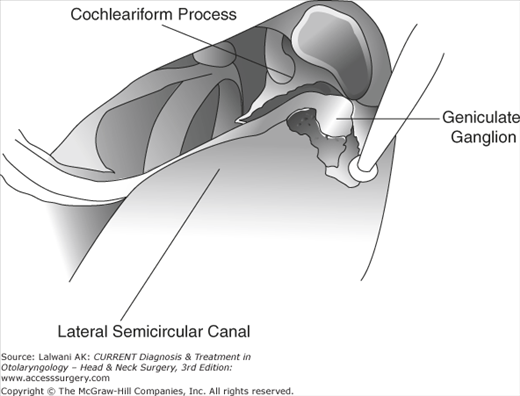Reanimation of the Paralyzed Face: Introduction
Facial paralysis can result from a wide variety of etiologies including infectious, neurologic, congenital, neoplastic, traumatic, systemic, and iatrogenic causes. Regardless of cause, the management of facial paralysis is complex and often requires multidisciplinary intervention. The evaluation and treatment of facial paralysis is especially intricate because of the wide variation in the potential for regeneration and lack of reliable prognostic indicators for spontaneous recovery. Current management of facial paralysis consists of a combination of pharmacologic therapy, physical therapy for facial neuromuscular retraining, and surgical intervention via dynamic and static techniques for facial reanimation. This chapter will focus on the wide variety of surgical therapies available to the reconstructive surgeon for successful facial reanimation.
Treatment
- Cause and duration of facial paralysis determine appropriate treatment
- The choice of reanimation procedure is primarily limited by the duration of facial paralysis.
Any surgical intervention for facial paralysis must carefully take into account the patient’s age, medical history, residual hearing, segment of nerve injured, and the patient’s expectations and risk tolerance. Management of acute facial paralysis may involve facial nerve decompression surgery in cases of virally induced facial paralysis (Bell’s palsy, Ramsay–Hunt syndrome) or traumatic facial paralysis. Primary facial nerve repair/grafting is undertaken in cases of resection or transection of the facial nerve.
The transmastoid approach for facial nerve decompression (Figure 71–1) can be utilized when the trauma is clearly localized to the tympanic or mastoid segments of the facial nerve. The nerve should be decompressed for 180° of its circumference. Important landmarks for this approach include the lateral semicircular canal, fossa incudis, and digastric ridge. The incus can be removed and then replaced as an interposition graft to achieve decompression of the tympanic segment of the facial nerve all the way to the geniculate ganglion.
The middle fossa approach allows decompression of the facial nerve when the injury extends to the labyrinthine segment. It is sometimes used in combination with the transmastoid approach in cases of temporal bone trauma. Critical landmarks for this approach include the superior semicircular canal, the greater superficial petrosal nerve, and “Bill’s bar” or the vertical crest separating the facial nerve from the superior vestibular nerve.
The translabyrinthine approach can be utilized for decompression of the entire intratemporal course of the facial nerve in cases where cochleovestibular function is absent or has been destroyed by the trauma.
Primary neurroraphy provides the best return of facial nerve function. However, the primary repair should be tension free. This sometimes necessitates rerouting or mobilization of the adjacent facial nerve segments in order to provide a tension-free anastomosis. It is important to note that the distal nerve segments can be identified intraoperatively by electrical stimulation for up to 72 hours after nerve transection or injury, making early repair critical. Most authors today recommend epineurial repair of the facial nerve as suture placement with fascicular or perineurial repair is difficult and may injure the axons.
Cable nerve grafts are utilized when a tension-free primary nerve repair is not possible. Popular choices for donor nerve grafts include: great auricular nerve, sural nerve, and the medial and lateral antebrachial cutaneous nerves. The ansa cervicalis has been used as a donor nerve as well as there may be some evidence that motor nerve grafts are better than sensory nerve grafts. With either primary nerve repair or cable grafting, it is generally accepted that the best possible outcome is House–Brackmann Grade III facial function.
The treatment of intermediate duration facial paralysis typically occurs in the setting of an anatomically intact facial nerve that has not recovered well. For example, facial paralysis after acoustic neuroma surgery in which the nerve is often intact but can have poor recovery due to stretch injury. Nerve transfers and nerve crossover procedures are typically the treatment of choice in this period as the native facial musculature is still viable.
Cross-facial nerve grafting can be utilized if the contralateral facial nerve is intact and functional. Terzis et al believe that the best outcomes from cross facial nerve grafting are if the period of denervation is less than 6 months. The surgical technique is a two-stage procedure. In the first stage, a modified preauricular face-lift incision is utilized on the normal, functional side of the face. After elevation of a skin flap anteriorly to the level of the lateral canthus, the superficial muscular aponeurotic system layer is penetrated anterior to the parotid gland and the branches of the facial nerve are identified using a nerve stimulator. Nerve branches are carefully selected for sacrifice depending on the desired innervations function and mapping of the innervations targets of each branch. A long sural nerve graft is tunneled to the contralateral face and the donor facial nerve branches are then sacrificed. Under magnification, the proximal end of the sural nerve graft is then coapted to the donor facial nerve branches (Figure 71–2). After a waiting period of 9 to 12 months, the second stage can be undertaken. In the second stage, secondary neurorraphies are performed between selected facial nerve branches and the cross face nerve grafts. Historically, however, cross-face nerve grafting has been fraught with unreliable outcomes. If the period of denervation is longer than 2 years, cross facial nerve grafting can be utilized in conjunction with free muscle transfer for smile reanimation as a more reliable procedure (discussed below).
Stay updated, free articles. Join our Telegram channel

Full access? Get Clinical Tree



